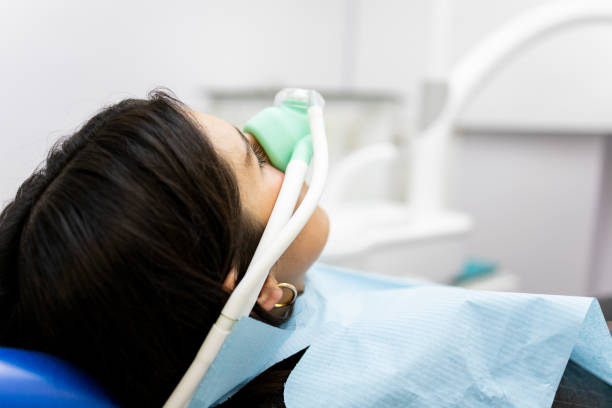
Visiting the dentist can be an overwhelming experience for many people. Dental anxiety is a common issue that prevents individuals from getting the care they need.
Fortunately, sedation dentistry at Smile Line Dentistry offers a solution, ensuring comfort and relaxation during dental procedures such as dental implants. But what exactly is sedation dentistry, and how can it benefit you?
Let’s dive into the different types of sedation used in dentistry and how they can make your next dental visit stress-free.
Sedation dentistry at Smile Line Dentistry involves the use of medication to help patients relax during dental procedures. It is especially beneficial for those with dental phobia, sensitive teeth, a low pain threshold, or difficulty sitting still for extended periods.
Depending on the level of anxiety and the procedure, different sedation methods are used to ensure maximum comfort.
Sedation dentistry provides numerous advantages, including:
Not sure if sedation dentistry is right for you? Consider it if you:
Some misconceptions prevent patients from exploring sedation dentistry. Here are some common myths debunked:
Sedation dentistry comes in several forms, each suited for different procedures and levels of anxiety. Let’s explore the different types of sedation used in dental treatments.
We'll cover the spectrum, from the lightest touch to the deepest sleep: minimal sedation, moderate sedation, deep sedation, and general anesthesia.
Choosing the right type of sedation depends on several factors: your level of anxiety, the complexity of the procedure, your medical history, and your dentist's recommendation.
With minimal sedation, you're awake but relaxed. You can respond to verbal commands, and you're generally aware of your surroundings.
Minimal sedation is often used for routine procedures like cleanings, fillings, or simple extractions.
Pros: Easy to administer, minimal side effects, quick recovery.
Cons: May not be sufficient for highly anxious patients or complex procedures.
Moderate sedation, sometimes called conscious sedation, puts you in a more relaxed state. You may feel drowsy and your speech might be slurred, but you can still respond to verbal cues.
Moderate sedation is typically administered orally or intravenously.
This level of sedation is suitable for more involved procedures like root canals, wisdom tooth extractions, or implant placement.
Side effects can include drowsiness, nausea, and headache. Risks are generally low but can vary depending on the patient's health.
Deep sedation brings you to a state where you're barely conscious. You may still respond to painful stimuli, but you won't be aware of the procedure.
Deep sedation is often used for complex oral surgeries or for patients with severe dental anxiety.
Deep sedation is similar to general anesthesia, but with deep sedation, you can still breathe on your own.
General anesthesia renders you completely unconscious. You're completely unaware of the procedure and feel no pain.
General anesthesia is typically reserved for extensive oral surgeries, patients with certain medical conditions, or very young children.
General anesthesia carries slightly higher risks than other forms of sedation and requires careful monitoring.
Oral sedation involves taking medication in pill form before your dental appointment.
Common medications include benzodiazepines like Valium or Ativan.
Advantages: Easy to administer, non-invasive.
Disadvantages: Effects can be unpredictable, not suitable for all patients.
Inhalation sedation involves breathing in a gas, typically nitrous oxide, also known as laughing gas.
Nitrous oxide helps patients relax and reduces anxiety.
Benefits: Quick onset and recovery, easily adjustable.
Drawbacks: Not effective for all levels of anxiety, can cause nausea in some patients.
IV sedation involves administering medication directly into a vein.
Pros: Precise control over the level of sedation, rapid onset.
Cons: Requires a trained professional, slightly higher risk of complications.
IV sedation is suitable for patients with moderate to high anxiety, those undergoing complex procedures, or individuals who prefer a deeper level of relaxation.
The effectiveness of each type of sedation varies depending on the individual and the procedure.
Sedation costs vary depending on the type of sedation, the length of the procedure, and the location.
Recovery time varies depending on the type of sedation used.
Your dentist will provide specific instructions, which may include fasting, avoiding certain medications, and arranging for transportation.
Communicate your concerns with your dentist, wear comfortable clothing, and try to relax before your appointment.
Sedation dentistry can be safely used in children to make dental visits less traumatic.
Sedation can help patients with physical or cognitive disabilities receive necessary dental care.
Sedation is a valuable tool for managing dental anxiety and fear.
Both of our offices feature the latest in dental advancements. Since 2006, Dr. Mona Sidhu and her team have provided exceptional dental care with our services in the California Bay Area.
Call us today to schedule an appointment!

Sedation dentistry transforms the dental experience for anxious patients, making treatments comfortable and stress-free. By understanding the different types of sedation dentistry, you can make an informed decision about the best option for your needs.
Whether you need minimal sedation for a routine cleaning or deep sedation for a complex procedure, sedation dentistry at Smile Line Dentistry ensures a pain-free, anxiety-free experience.

We are proud to provide our patients with the best in dental technology, treatment options and patient comfort. It is our pleasure to address all your questions and concerns.